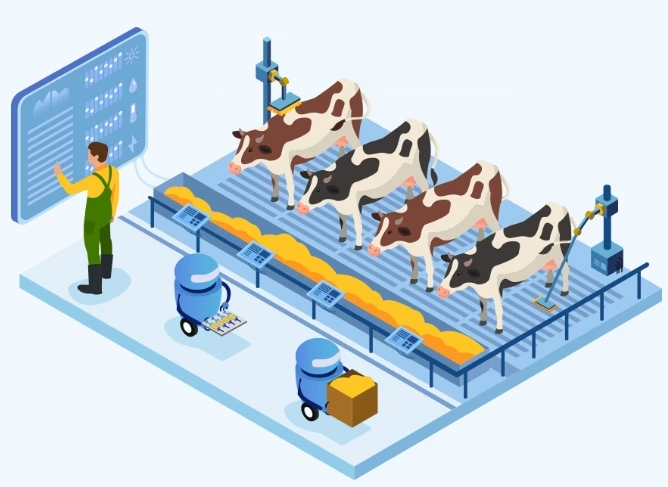Maximize herd health and profitability with advanced dairy management tools. Ready to rethink how to care? Discover how real-time insights and custom alerts can transform your herd.

Imagine the power to boost your herd’s productivity while cutting health costs—a dream for every dairy farmer. Healthy cows produce more milk and require less intervention, directly impacting profitability. How can you ensure this consistently? Health-focused herd management tools are the answer. These tools provide valuable insights and preventative measures to maintain a thriving herd. They help you monitor cow care, offer real-time alerts, and allow for data comparison, enabling swift, informed decisions. Integrating these tools can revolutionize your dairy farming. Ready to take control of your approach and boost your profitability? These innovative tools can transform your dairy farm.
Preventative Measures: The Cornerstone of Effective Herd Health Management
Preventative measures form the cornerstone of effective herd health management. These measures, like regular vaccinations and nutritional planning, preemptively tackle health issues, safeguarding the herd’s overall well-being. Tailored vaccination protocols target pathogens specific to the herd’s unique circumstances, significantly reducing disease incidence and associated costs. Strategic nutritional plans further bolster cows’ immune systems, making them more resilient against infections and other health challenges.
Despite meticulous preventative strategies, unforeseen factors can still threaten herd health. Environmental changes, such as sudden shifts in weather patterns or natural disasters, can destabilize the herd’s living conditions, leading to stress and increased health issues. Unforeseen disease outbreaks can rapidly spread, undermining even the most rigorous measures. In these situations, quick, calculated interventions are crucial. Advanced herd management tools with real-time monitoring and rapid response capabilities enable farm managers to adapt strategies, swiftly maintaining herd health and productivity.
Real-Time Monitoring: A Game Changer in Dairy Herd Management
Real-time monitoring and alerts play a pivotal role in cow care, significantly enhancing the speed and precision of decision-making. These systems continuously track health metrics and send instant notifications, allowing for prompt interventions and preventing minor issues from escalating into major crises. This approach ensures early treatment, thereby improving overall cow health. With up-to-date data, you and your team can swiftly adjust management practices, ensuring animal welfare and profitability.
The Health Index: A Comprehensive Metric for Herd Well-Being and Economic Sustainability
The health index value is a comprehensive metric for gauging each animal’s well-being. It compiles data on age and health-related costs, such as treatments and vet visits. This index lets you identify animals that underperform or use excessive healthcare resources.
Assigning a numerical health index to each animal helps you pinpoint those contributing disproportionately to healthcare costs, facilitating decisions on whether to invest in their health or cull them. Customizing the thresholds for your health index allows for a tailored approach that meets your operational and financial goals.
Notably, the health index aids in predicting future health events and costs, supporting proactive herd management. Monitoring and adjusting based on these values can improve overall herd health and optimize efficiency and profitability. Thus, the health index becomes vital for managing animal health and economic sustainability.
Customizing Health Index Thresholds: Essential for Identifying High-Risk Animals and Making Informed Herd Decisions
Customizing Health Index thresholds is crucial in identifying high-risk animals and making informed herd decisions. By adjusting these thresholds based on age, breed, and past health events, you can better evaluate your herd’s unique needs. This allows for early intervention on animals falling below expectations, preventing minor issues from becoming costly health events.
A tailored Health Index threshold also helps identify animals that pose significant risks to herd health and economic sustainability. By pinpointing these animals, you can decide their place in the herd. This focused approach ensures efficient resource allocation, boosting productivity and reducing health expenses. Ultimately, this strategy improves herd health and enhances profitability.
Dynamic Benchmarking: Elevating Herd Health Insights with Contextual Precision
Benchmarking against industry averages helps dairy managers gauge their herd’s health and performance relative to market standards. While this identifies strengths and weaknesses, static benchmarks can be misleading due to seasonal and regional variability. Dynamic benchmarking filters state, breed, and herd size comparisons, offering precise and relevant insights. This empowers managers to make informed, timely, and region-appropriate decisions, ultimately boosting herd health and profitability.
Customization: The Key to Harnessing the Full Potential of Herd Management Tools
Customizing data reporting is essential for effectively leveraging herd management tools. Each dairy operation has unique challenges, and a generic reporting system won’t work. Focusing on specific health events like mastitis, ketosis, metritis, and pneumonia allows you to monitor these critical issues closely. Fine-tuning filters within your reporting system help you efficiently sift through data, ensuring you get information that matches top management priorities. This customization equips you with relevant data for timely decisions, securing herd health and financial sustainability.
Centralized Health Data Analysis: A Pillar for Enhanced Dairy Herd Management
Centralizing health data analysis offers significant advantages for dairy herd management. By providing a comprehensive view of the herd’s health, multiple data streams can be integrated into one platform, allowing herders to identify trends and address potential issues before they escalate quickly. This centralized approach can bring relief, knowing that all the necessary information is at your fingertips, ready to be interpreted and acted upon.
Moreover, a centralized tool enhances decision-making by consolidating health metrics and historical data, which can be easily accessed and interpreted. This helps managers prioritize resources and focus on high-risk areas, optimizing herd health and profitability.
In essence, centralizing health data improves the accuracy of health assessments. It supports a more responsive and economically sound herd management strategy. Integrating real-time data with historical trends allows herders to make informed, data-driven decisions, fostering a healthier, more productive herd.
The Bottom Line
Rethinking your dairy herd health tools can enhance cow care and boost financial returns. Using health-focused herd management software, farmers can gain critical insights, benchmark against peers, and create custom alerts for proactive measures. Real-time monitoring and dynamic benchmarking offer a detailed view of health trends, aiding in informed decisions. Customizing Health Index thresholds and centralizing data analysis help manage costs and improve herd well-being. Integrating these tools reduces health risks and ensures a profitable, sustainable operation. Embracing these innovations leads to healthier herds and resilient businesses.
Key Takeaways:
- Utilize herd management tools to gain valuable insights into your herd’s health and performance compared to industry peers.
- Implement real-time monitoring and alerts to avoid potential health issues and make informed decisions.
- Customize Health Index thresholds to identify high-risk animals and evaluate their impact on your herd’s bottom line.
- Leverage dynamic benchmarking to compare your herd’s performance with peers, considering factors like state, breed, and herd size.
- Tailor your herd management software to track standard and custom health events and analyze data effectively.
- Centralize health data to streamline analysis, identify trends, and make smarter management decisions.
Summary:
Dairy farmers can enhance their profitability by using health-focused herd management tools. These tools offer valuable insights and preventative measures, enabling farmers to monitor cow care, provide real-time alerts, and compare data for swift, informed decisions. The Health Index is a comprehensive metric for gauging animal well-being and economic sustainability, compiling data on age and health-related costs. Customizing the thresholds for the Health Index allows for a tailored approach that meets operational and financial goals. Adjusting these thresholds based on age, breed, and past health events provides for early intervention on animals falling below expectations. Dynamic benchmarking helps dairy managers gauge their herd’s health and performance relative to market standards, providing precise insights. Customization is critical to harnessing the full potential of herd management tools, with specific health events like mastitis, ketosis, metritis, and pneumonia allowing for close monitoring and fine-tuning filters within reporting systems. Centralized health data analysis improves the accuracy of health assessments and supports a more responsive and economically sound herd management strategy.












